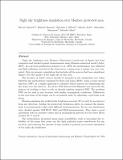Por favor, use este identificador para citar o enlazar a este item:
http://hdl.handle.net/10261/237112COMPARTIR / EXPORTAR:
 SHARE SHARE
 CORE
BASE CORE
BASE
|
|
| Visualizar otros formatos: MARC | Dublin Core | RDF | ORE | MODS | METS | DIDL | DATACITE | |

| Título: | Night sky brightness simulation over Montsec protected area |
Autor: | Linares, Hector; Masana, Eduard; Ribas, Salvador J.; Aubé, Martin; Simoneau, Alexandre; Bará, Salvador | Fecha de publicación: | 2020 | Editor: | Elsevier | Citación: | Journal of Quantitative Spectroscopy and Radiative Transfer 249: 106990 (2020) | Resumen: | Night sky brightness over Montsec Observatory (north-east of Spain) has been computed and checked against measurements using Illumina numerical model [2]. In a previous publication [20] the methodology was validated and light pollution received in the observatory coming from a unique city was computed. Here we present a simulation that includes all the sources that has a significant impact over the quality of the night sky in this area. The decision of which sources should be included in the simulations was taken following the methodology explained by [6]: using a point spread function (PSF) as a simple approach to estimate which sources are brightening the sky dome over the observer. An ad hoc PSF derived with Illumina was used with the purpose of avoiding to have to rely on already existing empirical PSF. The resulting PSF can be used in any location with similar atmospheric conditions. Differences in the spectrum of the lamps can be accounted easily by adjusting a spectrum scale factor. Illumina simulates the artificial sky brightness received (W/sr/m2) by an observer from any direction. Adding the natural sky brightness allows to compare the simulations to measurements taken with different instrumentation. In our case simulations were checked against ASTMON, SQC and SQM measurements. They show a good agreement both in absolute values and in geographical patterns for the three filters studied, B, V and R. The methodology presented opens many possibilities, such as increasing the reliability of the maps that point out the light pollution main contributors for any location, and reducing the amount of time needed to perform an accurate simulation of the night sky brightness. | Versión del editor: | https://doi.org/10.1016/j.jqsrt.2020.106990 | URI: | http://hdl.handle.net/10261/237112 | DOI: | 10.1016/j.jqsrt.2020.106990 | ISSN: | 0022-4073 |
| Aparece en las colecciones: | (ICE) Artículos |
Ficheros en este ítem:
| Fichero | Descripción | Tamaño | Formato | |
|---|---|---|---|---|
| Nightskybrightnesssimulationsover.pdf.pdf | 6,68 MB | Adobe PDF |  Visualizar/Abrir |
CORE Recommender
SCOPUSTM
Citations
8
checked on 01-abr-2024
WEB OF SCIENCETM
Citations
9
checked on 28-feb-2024
Page view(s)
69
checked on 22-abr-2024
Download(s)
225
checked on 22-abr-2024
Google ScholarTM
Check
Altmetric
Altmetric
NOTA: Los ítems de Digital.CSIC están protegidos por copyright, con todos los derechos reservados, a menos que se indique lo contrario.
